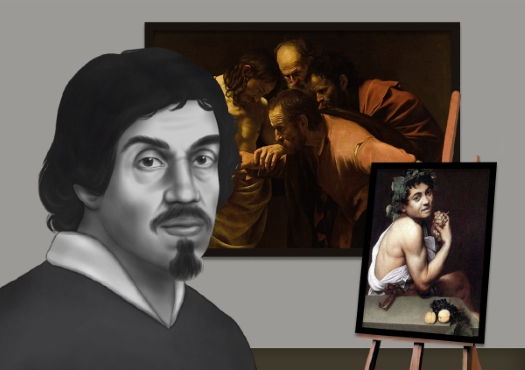Summary of Caravaggio
The passion and intensity of Caravaggio's paintings was mirrored by his violent and turbulent lifestyle. Despite countless run-ins with the law, and being implicated in more than one murder, he still found it within himself to create a body of strikingly innovative work. Caravaggio pioneered the use of sharp contrasts in lighting to maximize dramatic effect, and reimagined religious figures by dressing them in modern clothes, and by placing them in modern interiors. Working from life, and without preparatory sketches, Caravaggio’s pairing of naturalistic observation of his models (who were often beggars, criminals, and prostitutes), with the expressive use of chiaroscuro lighting, gave rise to a unique style that became widely imitated. Even though he only lived until the age of 38, Caravaggio had a profound influence on later art movements, most notably Baroque art and 19th-century Realism.
Accomplishments
- By representing biblical characters in a naturalistic fashion, typically through signs of aging and poverty, Caravaggio's populist modernization of religious parables were little short of trailblazing. Although not without his critics within the church, by effectively humanizing the divine, Caravaggio made Christianity more relevant to the ordinary viewer.
- Whilst the technique of chiaroscuro was not introduced by Caravaggio, he was the first painter to incorporate the technique as a dominant stylistic feature, making his shadows darker, and painting clearly defined rays of light to spotlight the drama of his narratives. The style became increasingly prevalent in his later work and his art was a shaping influence on Baroque painting.
- Caravaggio never married and had no children. This, and his sensual portrayals of young men (in conjunction with a lack of erotic female characters in his work), has led to much speculation surrounding his sexuality and there have been several contemporary homoerotic readings of his work. Indeed, he has emerged as an icon within the gay/queer community.
- A vital component of Caravaggio’s legend is built on a way of life that seemed wholly irreconcilable with the great artworks he produced. While there is today a tremendous “romance” around Caravaggio’s myth, one wonders how he (not to mention his influential patrons), as a violent fugitive, possibly a whoremonger, and a convicted murderer, would have weathered current moral mores and sensibilities were he living and working today.
The Life of Caravaggio
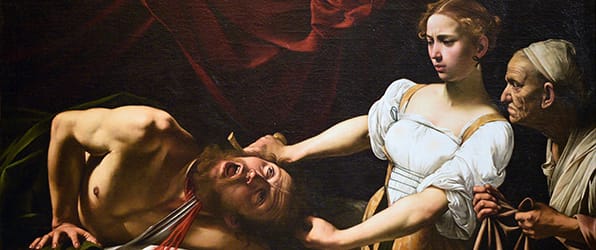
By the age of 21, Caravaggio had lost his entire family to the bubonic plague, and throughout his short life, his violent temper got him into heaps of trouble, forcing him to flee from city to city. Nevertheless, his highly dramatic personal life didn’t stop him from becoming a preeminent Italian master of highly dramatic art.
Important Art by Caravaggio
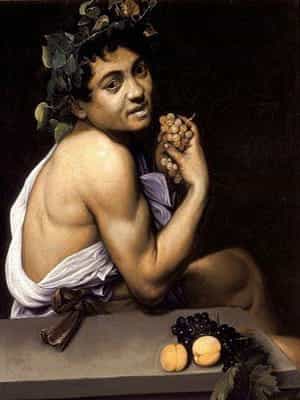
Sick Bacchus
Caravaggio executed this self-portrait whilst in the employment of the mural painter, Giuseppe Cesari. The painting's carefully worked still life elements clearly demonstrate the influence of Cesari's teachings. However, Caravaggio had quickly become frustrated with painting decorative flowers and fruit which he considered a “lowly subject matter.” He pushed Cesari for the opportunity to paint human figures and was granted his wish. As historian Andrew Graham-Dixon states, this painting, and a companion work, Boy with a Basket of Fruit (1593-94), were probably not commissioned, and more likely painted by Caravaggio “as demonstration pieces: proof to his master that he could indeed paint more-ambitious subjects”.
The painting is one of a group of the artist's early self-portraits that seems to have been painted with the aid of a convex mirror, a contention supported by the figure's awkward pose, as if turned to ensure better visibility in the mirror surface. The work’s title, Sick Bacchus (also known as Self-Portrait as Bacchus), seems fitting given the subject's pale appearance and dark, hooded eyes. The art historian Roberto Longhi believed that the artist painted it after he was discharged from the hospital, following an incident in which he was kicked by a horse and sustained severe injuries. Alternatively, the image's greenish coloration might simply be ascribed to a night-time setting appropriate for the bacchanalia (festival of Bacchus) which was about to ensue.
The figure of Bacchus was a fitting alter-ego for Caravaggio as he was the deity of wine, theater, ritualized displays of ecstasy, and was synonymous with inspiration and destruction. The portrait differs, however, from traditional representations of Bacchus where he is depicted in the midst of unbridled celebration, often in a verdant landscape. Instead, Caravaggio's image adheres to the conventions of many of the artist's other works, presenting the mythological figure in a sparse interior. Furthermore, the figure’s pallor and sitting pose suggest not a deity in his prime, but rather someone enduring the consequences of over-indulgence. Indeed, the ivy leaves encircling the Bacchus’s head have started to wither, a few of the grapes in his hands have begun to shrivel, and the two lush apricots in the painting's foreground betray the beginning brown spots of rot.
American photographer Cindy Sherman did much to raise the profile of the painting amongst contemporary art lovers when she reinterpreted it as part of her History Portraits (1988–90) series. Untitled #224 (after Caravaggio's Bacchus) (1990) was one of a series of photographic portraits in which Sherman assumed the role of male figures borrowed from Renaissance, Baroque, Rococo, and Neoclassical portraiture.
Oil on canvas - Galleria Borghese, Rome
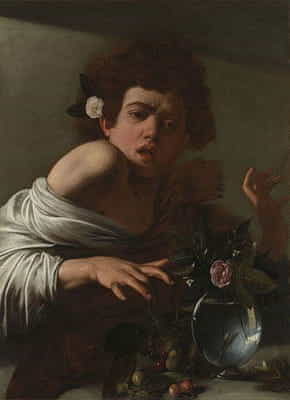
Boy Bitten by a Lizard
Here, a young boy, an example of the tousled, curly-haired youth who populated many of Caravaggio's early secular pieces, recoils in pain and surprise after having reached for one of the fruits on the table only to be bitten by a lizard, concealed among the pile of cherries. Although Caravaggio condemned Classical statuary, the boy's expression may have its root in the expression of horror found in the ancient statue of Laocoön and His Sons (unearthed in Rome in 1506), and the lizard is reminiscent of the reptile portrayed in the ancient Roman sculpture Apollo Sauroktonos the Lizard Slayer which Caravaggio would have come across while living in Rome.
On the table, Caravaggio demonstrates his skill in rendering the play of light over and through different textures. In keeping with Caravaggio's burgeoning style, the boy exists in a nondescript, timeless interior, with blank walls punctuated only by a stark, diagonal light source originating from the upper left, and outside the frame of the painting. This heightens the intense expression of the piece, as it highlights the boy's bare right shoulder, raised as he recoils from the bite; his furrowed brow and mouth open in a gasp of horror. Commenting on the originality of Caravaggio’s technique, London’s National Gallery notes that it was “very unusual for a late sixteenth-century painting to show such a moment of action, but Caravaggio rejected artistic convention and painted directly onto the canvas from live models [thereby giving] his works an immediacy and intensity that made them instantly popular.”
The painting is most notable today for its sexual subtext. In the Italian street slang of Caravaggio's day, bitten fingers represented a wounded phallus, and the artist's inclusion of jasmine, a traditional symbol of sexual desire, in combination with the lizard lurking beneath the cherries and apples (each signifiers of temptation) suggests that the painting illustrates the perils of indulging in sexual appetites. Caravaggio’s art has raised many questions about his sexual preferences, and his sexuality has been a matter of debate amongst historians. He has emerged, however, an icon within the gay/queer community. For art critics such as Jonathan Jones, “it is the risk of Caravaggio's sexual passion for male flesh”, indeed, that gives “his art its incomparable kick of reality.”
Oil on canvas - The National Gallery, London
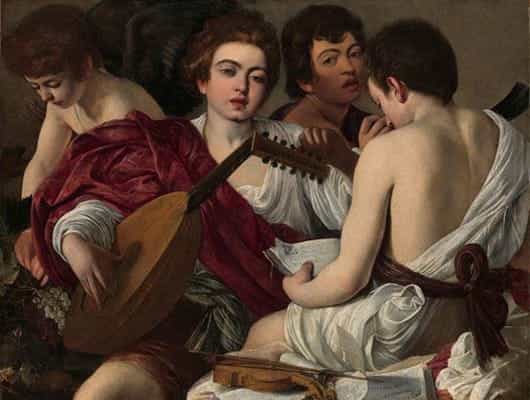
The Musicians (Concert of Youths)
This work, unusual for its time, is an example of the Venetian “concert picture”; a genre exemplified by Titian's 1510 work, The Pastoral Concert, which celebrates the natural joys of musical performance. This image, however, subverts the genre by focusing on the rehearsal rather than the performance itself. The inclusion of the classical robes of the musicians, and the winged cupid in the upper left of the image, signals a symbolic intent that links music, love, and wine (the latter represented by the grapes in the cupid's hand). The closely arranged figures crowding the image seem to have been drawn separately and brought together for the final composition.
The central musician has been identified as Caravaggio's companion, Mario Minniti, while the face looking over his left shoulder is possibly a self-portrait. The musicians are rehearsing madrigals, while the lute player is transported by the music, his wet eyes and dreamy expression suggesting perhaps melancholy or lost love. The inclusion of a violin in the foreground indicates the imminent arrival of another musician, possibly Cardinal Francesco Maria del Monte, who commissioned the work, and who emerged as Caravaggio’s greatest patron. Indeed, Caravaggio produced other concert pictures under his patronage (as well as devotional works for aristocrats in del Monte’s circle) and these were the pieces on which he made his name shortly after his arrival in Rome.
The painting was an early showcase for Caravaggio’s unique form of naturalism. Although his critics dismissed his subject matter (an “ordinary rehearsal” rather than musicians seen in concert or in a pastoral setting) as mundane, and clear evidence of the artist’s lack of creativity and imagination, his delicate handling of light and form would prove inspirational for future artists. Unlike other masters, Caravaggio never established a workshop. Nor did he develop a philosophical school of thought. But the psychological realism for which he has become renowned – what was, in effect, a kind of secular painting composed under the umbrella of the Church – gave rise to the so-called “Dutch Caravaggisti," a group of admirers including figures of the stature of Rembrandt, Judith Leyster, and Johannes Vermeer, all of whom used his example as a template on which to develop their own style of realistic painting.
Oil on canvas - The Metropolitan Museum of Art, New York
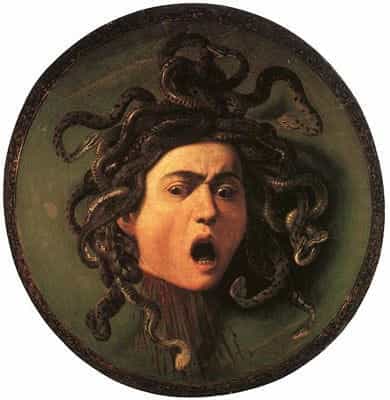
Medusa
This painting depicts the monster of Greek myth whose hair was made of snakes and whose gaze alone turned viewers to stone. The Medusa was finally defeated by the hero Perseus who beheaded her by cleverly viewing her indirectly through her reflection in his polished shield. Caravaggio depicts Medusa taking her final breath, immediately after the moment of her beheading, and in the sudden realization of the horror of her fate. Caravaggio's skilled and subtle contrasts of light and shadow show the head of Medusa in three dimensions.
It is widely thought that Caravaggio’s Medusa is a self-portrait. As such, his audacious reversal of gender (Caravaggio’s Medusa appears almost androgynous) is often referenced in discussions about the artist's ambiguous sexual orientations.
Meanwhile, in keeping with Caravaggio's interest in representing the world as it appeared and drawing from life, he used live snakes (common water snakes were native to the Tiber River) to model Medusa's writhing vipers. The green of the reptiles, and that of the background, contrasts strongly with the red blood of the decapitated head, highlighting the visceral nature of the image.
Jones writes, “Caravaggio was commissioned to make this monstrosity as a gift for the Grand Duke of Tuscany; conceived to enter the Medici collection in Florence, it would enable Caravaggio to compete with Leonardo da Vinci, by this time dead for 80 years. This painting decorates a convex wooden shield, surely alluding to a story about the young Leonardo, whose father once asked him to decorate a shield. Leonardo went into the fields, collected snakes, lizards and insects, and assembled them into a hybrid monster which he painted on the shield. The tale of Leonardo's monster is about art and power: decorating a warlike object, the artist imposes his imagination on the world, creates an image with disturbing power. That is what Caravaggio does here.”
Oil on canvas mounted on wood - The Uffizi Gallery, Florence
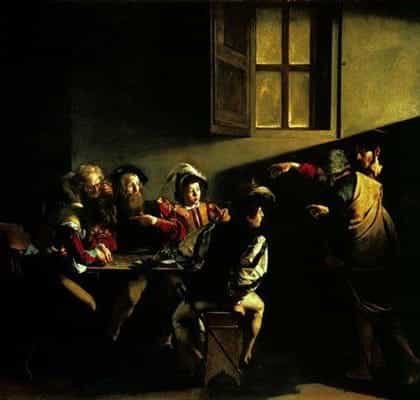
The Calling of St. Matthew
In this image, Caravaggio depicts a moment from the Gospel of Matthew, in which Christ, accompanied by St. Peter, beckons the tax collector Matthew to join him as a follower. The person of Matthew has been variously identified, but most interpretations cite the bearded, central figure to be Matthew, as this figure's gesture, a hand with an extended finger pointing towards his chest, seems to be asking: "who, me?". Others have suggested that Matthew is the younger man with bowed head at the end of the table and this may have been an attempt by Caravaggio to be intentionally ambiguous. Art historian Andrew Graham-Dixon attributes a political meaning to this composition. Completed around 1600, the year the French king Henri IV married Marie de'Medici, he reads St. Matthew's slow rousing from "spiritual slumber by the coming of Christ" as an allusion to the French king's own conversion from Protestantism to Catholicism.
Formally, this painting is a notable example of two of the artist's stylistic traits: his depictions of holy figures in the guise of modern-day Romans, and his unique use of light. The figures around the table are dressed as members of the early-17th-century middle classes while Jesus and St. Peter are more simply clothed, and barefoot. Their faces are realistic and non-idealized. The only iconographic nod to the holy context of the scene is the faint, foreshortened gold halo above Christ's head, which is partly obscured by the diagonal beam of blinding light. These details, and the fact that Caravaggio set the scene in what Graham-Dixon called “a dingy modern tax collector’s office somewhere in a basement of Rome”, caused many critics to express dismay at the image and accuse the artist of blasphemy.
Although Caravaggio includes a prominently placed open window in the image, it provides no light; the brightness instead originates outside the picture frame and is suggested as an otherworldly accompaniment to the divine presences of Christ and St. Peter. Caravaggio used this dramatic light source to integrate the chapel space into the world of the painting. Though its origin is not visible within the picture, the upper right light source was meant to connect to the natural illumination of the chapel itself and was an extension of the light emanating from a window directly above the chapel altar. The artist thus created continuity between the scene of Matthew's calling and the chapel in which it was situated.
Oil on canvas - San Luigi dei Francesi, Rome
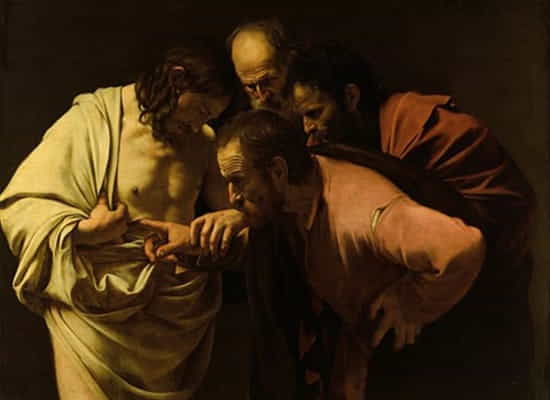
The Incredulity of Saint Thomas
The Incredulity of Saint Thomas is one of the most copied and reproduced of all Caravaggio paintings. According to the gospel of St. John, Thomas (one of the twelve apostles) had missed Christ's appearance after the Resurrection and insisted that "Unless I see the nail marks in his hands and put my finger where the nails were, and put my hand into his side, I will not believe it." One week later, Christ appeared to Thomas instructing him: ”Reach hither thy hand, and thrust it into my side: and be not faithless, but believing.” Thomas was thus convinced (about the Resurrection) and proclaimed: “My Lord and my God!”, to which Jesus responded, “Because you have seen me, you have believed; blessed are those who have not seen and yet have believed.”
In Caravaggio’s composition, light streams into the image from the left side of the frame, bathing Jesus in a warm glow. He and the apostles are tightly arranged, with Jesus and Thomas occupying the forefront. Caravaggio's painstaking attention to veristic (a realistic style in Roman portraiture) detail is most evident in the torn seam on the left shoulder of Thomas's shirt, on the marks on Jesus's torso, and in Thomas's dirty fingernails. Moreover, while The Incredulity of Saint Thomas was a popular subject in Renaissance and Baroque art, Caravaggio's gruesome focus on Thomas's finger probing Christ's gaping wound distinguished the work from all others on the same theme.
In his analysis of the painting, art historian E. H. Gombrich writes: “One can imagine that such a painting struck devout people as being irreverent and even outrageous. They were accustomed to seeing the apostles as dignified figures draped in beautiful folds – here they looked like common labourers, with weathered faces and wrinkled brows. But, Caravaggio would have answered, they were old labourers, common people.” Gombrich adds that Caravaggio’s painting placed him in the company of such greats as “Giotto and Dürer before him” since, like them, he had “wanted to see the holy events before his own eyes as if they were happening in a neighbour’s house.” Despite the belief that Caravaggio always worked with live models, the English artist, David Hockney, caused controversy when he argued that Caravaggio must have traced using a camera obscura for the painting because none of the figures seem to be looking directly at the wound on Christ’s body.
Oil on canvas - Sanssouci, Potsdam, Berlin

Amor Vincit Omnia
Amor Vincit Omnia stands as a striking testament to Caravaggio’s command of dramatic realism. The painting captures Cupid, the Roman god of love, in a triumphant pose, his mischievous smile hinting at the playful yet powerful nature of love. Through a masterful interplay of light and shadow, Caravaggio brings Cupid’s youthful form to life, emphasizing the sensuality of the human body with remarkable detail. The composition's dramatic tension invites viewers into the scene, urging them to linger on Cupid’s subtle gestures and expressions, which pulse with vitality and immediacy.
At its core, this painting serves as a rich allegory of love’s dominance over all facets of life. Cupid confidently stands over scattered symbols of human achievement—musical instruments, armor, and a laurel crown—signifying the futility of worldly pursuits, whether in art, science, or warfare, when measured against love’s overpowering force. Traditional elements like Cupid’s arrows and quiver underscore his inevitable victory in the realm of desire and passion. Moreover, the objects Caravaggio includes invite deeper interpretations, bringing together themes of both sacred and profane love—an exploration the artist frequently pursued. His portrayal of Cupid as both mischievous and sensual challenged conventional depictions, sparking debates about the delicate balance between the sacred and the earthly.
Commissioned by Vincenzo Giustiniani, a key patron of the arts in 17th-century Rome, this work resonates with the cultural and moral tensions of the Counter-Reformation. The painting’s sensual depiction of Cupid, intertwined with profound allegorical meaning, provoked both admiration and controversy among Caravaggio’s contemporaries. His daring approach—blending the divine with stark realism—solidified his reputation as an artist who defied the norms of his time.
Oil on canvas - Gemäldegalerie, Berlin
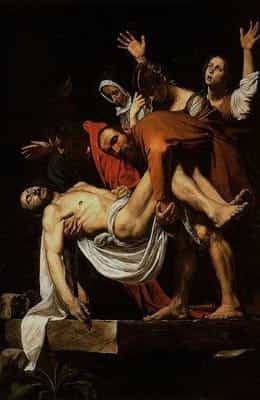
The Entombment/Deposition
Described by the Vatican Museum (which is now home to the painting) as “one of Caravaggio’s greatest masterpieces,” The Entombment was commissioned by Girolamo Vittrice for his family chapel in S. Maria in Vallicella (Chiesa Nuova) in Rome. The scene shows mourners carrying Christ's body to its burial place, with John the Evangelist in a red cloak supporting Christ's torso, and Nicodemus carrying Christ's legs. A distraught Mary of Clopas, a weeping Mary Magdalene, and a bowed Virgin Mary accompany Christ to his burial. As in his other work the figures are presented with a realism that belies their religious significance and this is enhanced by the red and brown tones of the image (representative of Caravaggio's palette in this period) which further serve to highlight the earthy normality of the participants. It is plausible that the composition was inspired by Michelangelo's 15th-century Pietá in St. Peter's Basilica, as Christ's limp body, dangling arm, and foreshortened chest and head echo the pose of Christ as seen from the front of the sculpture.
The painting is organized along a dramatic diagonal, with figures aligned in a descent from the top right of the picture to the lower left corner. Each person illustrates a progression of emotion commensurate with their position in the painting. The outstretched arms and extended palms of Mary of Clopas occupies the apex of the diagonal and suggests the initial reaction of disbelief and despair at Christ's execution. The composition then proceeds downwards to a weeping Mary Magdalene, her face concealed from the viewer; to the resigned, bowed head of the Virgin Mary; to Nicodemus, struggling under Christ's weight. He turns his face to the viewer as if to ask "what next?". The question is answered by John the Evangelist who focuses on the example of Christ himself, whose expression of serenity, peace, and acceptance of death completes the painting's emotional arc.
The painting was designed to hang above an altar and the stone tomb in the image echoes the shape and appearance of the altar. Consequently, Caravaggio extended the scene of burial into the space of the worshippers and the frontal light source beyond the plane of the painting appeared to emanate from the altar itself - a divine light of resurrection animating, and lending hope to the burial scene above.
Oil on canvas - Vatican City
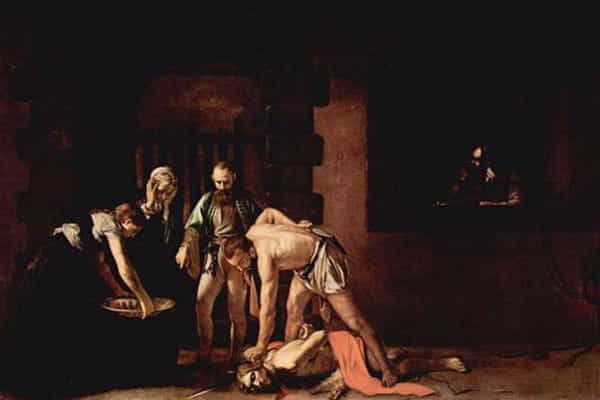
The Beheading of St. John the Baptist
This is Caravaggio's largest work and was painted as an altarpiece for the Oratory of San Giovanni Decollato, annexed to the Church of St. John in Valletta, in Malta. It is widely seen as one of Caravaggio's greatest paintings and was his passaggio - a gift customarily given following investiture into the Order of the Knights of Malta. This work is notable as the only piece Caravaggio ever signed. The blood pouring from John's head oozes into the artist's centrally-positioned signature which reads as “Fra Michael Angelo”, which, according to art historian Keith Sciberras, denotes the artist's new social status as Michelangelo, Knight of Malta. Scholars, including art historian Herwarth Röttgen, have understood Caravaggio's blood signature as an act of contrition, the artist professing his guilt and admitting his hand in the murder of a rival, the event which precipitated his flight and exile from Rome. Alternatively, art historian David M. Stone argues that the artist's decision to sign the work through St. John's blood should be read as a celebratory gesture, the artist marking his new life in Malta as a Knight and his subsequent newly elevated social status.
As with other works from his Maltese period, the figures are clustered together leaving large swathes of empty or less populated space above and adjacent to the focus of the action. As a consequence, although the artist imbues each actor with a unique emotion or response, individuality is subsumed to the collective illustration of the dramatic moment. The only figure who betrays a strong emotion in the image is the old woman. The artist's tenebrism relegates much of her face to shadow, but Caravaggio highlights her hands, grasping her head in horror. The old woman is the emotional corollary to the deceased St. John, and to the still calm of the other witnesses. The old woman's head, clasped in shock and dismay between her hands, represents the viewer's emotional entry into to the scene.
The painting typifies Caravaggio’s signature chiaroscuro technique which the 17th-century biographer Giovanni Pietro Bellori described thus: “He went so far in this style that he never showed any of his figures in open daylight, but instead found a way to place them in the darkness of a closed room, placing a lamp high so that the light would fall straight down, revealing the principal part of the body and leaving the rest in shadow.”
Oil on canvas - St. John's Co-Cathedral, Valetta, Malta
Biography of Caravaggio
Childhood
Reliable biographical information on Caravaggio’s early years is scarce and what does exist has been pieced together from court and municipal records and other surviving documents. He was the first child of Fermo Merisi, and his second wife, Lucia Aratori. As a boy, Caravaggio was known as Michelangelo Merisi, a reference to his birth on the feast day of the Archangel Michael (September 29). The artist grew up between the quiet agricultural town of Caravaggio in Lombardy, and the bustling city of Milan where his father, a master stone mason, ran his workshop (he was a qualified artisan, or mastro, entitling him to employ apprentices).
Although they were of lower social standing, Caravaggio's family had ties with Milanese nobility. Caravaggio's maternal grandfather, Giovan Giacomo Aratori, was a land surveyor, rent collector, and legal witness for the powerful Sforza dynasty. Aratori’s daughter (Caravaggio’s aunt) had served as a wet-nurse to the children of their family, notably the Marchese Francesco I Sforza di Caravaggio, and his wife, Costanza Colonna (they had witnessed the wedding of Caravaggio's parents in 1571). Costanza would later become a great support to the artist during his various flights from the law, although it seems she never personally acquired any of his paintings.
In August 1576, when Caravaggio was five years old, Milan suffered an outbreak of the bubonic plague. While the artist and his family retreated to the countryside, by October of 1577 his father, paternal grandparents, and uncle had all succumbed to the pox. The art historian Andrew Graham-Dixon writes, “By age six, Caravaggio had lost almost every [adult] male member of his family to the plague. His unruly and fiery temperament and his deep sense of abandonment may well have their origins in those traumatic events of his early childhood.”
Documents show that in April 1584, the twelve-year-old Caravaggio undertook an apprenticeship with the Milanese fresco master, Simone Peterzano. Although he showed little early aptitude for the art of fresco painting, Caravaggio did use his spare time to master the art of swordsmanship and became an accomplished duelist. By 1592, Caravaggio had also lost his mother and youngest brother. The family land was divided among the remaining siblings and Caravaggio left his hometown permanently for Milan where he supported himself through portrait painting.
Early Training and Work
It is probable that Caravaggio embarked upon his artistic career armed with a knowledge of Renaissance painters. Art historian David M. Stone notes that Caravaggio's work betrays the influence of numerous Italian masters, including Savoldo, Moretto, Lotto, Palma Vecchi, Titian, Giorgione, and Leonardo da Vinci. He almost certainly received some form of Classical education through his earlier apprenticeship under Peterzano and was aware of key texts of his time. As art historian Sharon Gregory has demonstrated, Caravaggio would have very likely studied Giorgio Vasari's 1550 The Lives of the Most Excellent Painters, Sculptors and Architects, from Cimabue until Our Own Time, and used Vasari's source text for some of his paintings.
Despite his formal training, many of the traits that would distinguish Caravaggio’s art were shaped by the energetic Milanese environment in which he spent these early years. As Graham-Dixon tells us, the city had fallen under the influence of a Counter-Reformation firebrand, Archbishop Charles Borromeo (later Saint Borromeo). As a staunch defender of the poor, Borromeo’s “tastes in religious art were correspondingly plain and robust”, and he “had little time for sophisticated, intellectually abstruse art in the High Renaissance or Mannerist vein.”
Caravaggio’s early biographer, Giulio Mancini, refers to legal documents from the late 1580s and early 1590s that show that the artist had sold his small plots of inherited land and left Milan (never to return) soon after in 1592. Rome, which was undergoing a religious revival under Pope Clement VIII (and with many churches needing decoration), had become a destination for many artists, but the precise reasons for Caravaggio’s departure were likely more urgent. Mancini notes in the margin of his original manuscript (written between 1617-21 but left unpublished until 1956), that the artist was involved, perhaps indirectly, in a violent episode that resulted in the death of a local policeman.
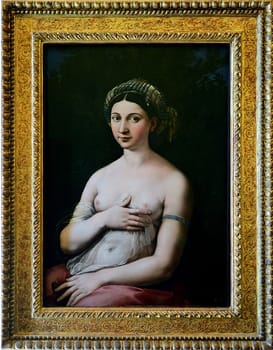
In Rome, Caravaggio took up lodgings with the Sicilian painter Lorenzo Siciliano. He then lodged briefly with a priest named Pandolfo Pucci (who he bitterly complained fed him only salad), before joining the studio of a somewhat inconsequential Sienese painter called Antiveduto Grammatica. Art historian E. H. Gombrich states that on his arrival in Rome, Caravaggio quickly “fell under the spell of Raphael’s works, which he greatly admired” and aimed henceforward “at recapturing something of their simplicity and beauty instead of deliberately contradicting them, as the Mannerists had done.”
Caravaggio spent several months as an assistant to the artist Giuseppe Cesari (aka Cavaliere d’Arpino). He was a more highly regarded fresco painter and Caravaggio was initially restricted to painting decorative borders featuring flowers and fruits. Despite his restlessness, Caravaggio developed a fine eye for detail and an affection for the nuances of still-life paintings (as is evident in the precise execution of fruits and flora in later works). Caravaggio hungered to paint human figures, however, and executed two important works while under Cesari’s tutelage: Boy with a Basket of Fruit, and Self-Portrait as Bacchus (also called Sick Bacchus) (both 1593-94).
Following his assistantship with Cesari, which came to an unhappy end after less than a year (their relationship was not helped by an obscure incident that involved a kick from Cesari’s horse that saw Caravaggio hospitalized), Caravaggio took up lodgings with the priest, Monsignor Fatin Petrigiani. Around this time, it is known that he also befriended Prospero Orsi, a painter of grotesques (a 16th century artistic phenomenon that, unlike the beauty and natural balance associated with Renaissance art, shifted focus onto the misshapen, the disproportionate, and the bizarre/grotesque). Caravaggio was inspired to paint a number of self-portraits at this time, although most, with the notable exception of Boy Bitten by a Lizard (1593-94), a vivid parable on the dangers of carnal activities, are now presumed lost.
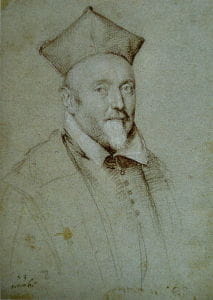
By now, Caravaggio was approaching picture sellers, one of whom was named Costantino Spata. The dealer knew that the well-connected music and art aficionado, Cardinal Francesco Maria del Monte, passed by his shopfront on a regular basis. With the specific aim of grabbing the attention of the passing del Monte, Caravaggio painted two pictures featuring scenes of everyday life, The Cardsharps (1594), and The Gypsy Fortune Teller (1594) which Spata displayed in his shop window. The Cardinal took the bait, purchasing both paintings.
Del Monte duly took Caravaggio under his wing, giving him lodgings and providing him with introductions to his circle of friends and contacts. He received commissions from del Monte, including The Musicians (1595-96), and others within his Roman circle. But del Monte was also an ambassador to the powerful Florentine Medici family. Through del Monte, Caravaggio painted what are now considered two of his most iconic pieces for the Medici: Bacchus (1596) and Head of the Medusa (1597). For the former, Caravaggio’s employed his friend, the Sicilian painter Mario Minniti, who had posed for Caravaggio in a number of early works. Bacchus bridged the gap between the “sacred and the profane” as he has been read simultaneously as a male prostitute and also an adumbration of Christ the Savior. Unusually, Medusa was painted on a circular canvas, stretched over a convex wood backing. The aim was to mimic the shape of Perseus's shield that (as the myth tells it) reflected Medusa's image back on itself. It also referenced the common practice of drawing Medusa on shields when going into battle to signify victory against overwhelming odds.
Caravaggio formed closed friendships within the Rome’s community of prostitutes and courtesans. One of this group was Fillide Melandroni. She acted as his model on several paintings from this period, including Martha and Mary Magdalene (1598), Saint Catherine of Alexandria (1598), and Judith Beheading Holofernes (1598). The latter made a strong impression on other artists, particularly the 17th-century Baroque painter Artemisia Gentileschi who created a number of images on the same subject matter. Caravaggio's religious paintings received very mixed reviews, however. With his preference for a veristic style (a realist technique borrowed from Roman portraiture that was often used to emphasize the experience and wisdom of mature/distinguished sitters), and his tendency to place holy figures in dark, modern (17th-century) interiors, he infuriated many church elders. Indeed, several Caravaggio works were rejected by commissioning institutions on the grounds of blasphemy or indecency.
Mature Period
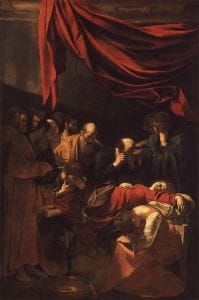
In 1599, Cardinal del Monte helped Caravaggio win his first major public works. He secured commissions for the decoration of the Contarelli Chapel in the church of San Luigi dei Francesci with three scenes from the life of St. Matthew (an altarpiece on the theme of Matthew and the Angel, which portrayed Matthew as an unkempt peasant, displeased the church elders and was later replaced with an image of the apostle in a more dignified light), and an appointment to paint the side walls of the Cerasi Chapel of Santa Maria del Popolo with The Conversion of St. Paul (1600) and The Crucifixion of St. Peter (1601). Overlapping the Cerasi Chapel commission, Caravaggio commenced work in earnest on his monumental, and possibly his most revered Roman masterpiece, The Entombment of Christ (1601-03) for the church of Santa Maria in Vallicella, Rome.
With these public commissions Caravaggio had introduced a new level of naturalism into religious art and, in this respect at least, he fell into line with the edict (issued in the 1550s) by the Council of Trent that had demanded a new form of Counter-Reformation art that could relate to the everyday lives of ordinary people. Indeed, between them, his public works helped earn Caravaggio the reputation as the most exciting artist working in Rome (even if some of the more conservative members of the Vatican hierarchy dismissed his art as “crude” and “blasphemous”).
Caravaggio had left del Monte’s household (but remained under his protection when faced with harassment from the law) in 1601, taking up new residence with the powerful Mattei family. He lived in the palace of Girolamo Cardinal Mattei, for whom he painted a number of pictures including The Supper at Emmaus (1601) and The Taking of Christ (1602) (in which he painted himself as a witness). Also, around this period, he painted what was to become, perhaps, his most famous single canvas (with at least twenty-two copies painted during the 17th century), The Incredulity of Saint Thomas (or Doubting Thomas as it has become known) (1601-02).
Also in 1602, Caravaggio painted a highly homoerotic depiction of Cupid, surrounded by objects related to the secular world (art, music, science, and the military), called Amor Vincit Omnia (translated as “love conquers all”, also known as Victorious Cupid). Commenting on this painting, and what it tells us about Caravaggio’s sexuality, art critic Jonathan Jones notes that it was “plainly […] painted from life,” which meant “a youth has stood naked in Caravaggio's studio, wearing fake wings.” He describes how Cupid “grins cockily as he displays his flesh, in a light that somehow leads all eyes directly to, well, the penis [and it] is overt sexuality, not romantic notion of love, that triumphs in this painting.”
Jones explains that, in its day, the painting was seen by many “as a personal confession [that] proved Caravaggio guilty of the crime they called ‘sodomy’, which in Caravaggio's case, outside of marriage, plainly meant homosexuality.” Indeed, while contemporary critics like Jones see Caravaggio’s homosexuality “at the heart of his genius,” and paintings such as Amor Vincit Omnia as “acts of defiance in an age when the wrong kind of love could get you executed” (Jones argues, in fact, that Caravaggio took “the noble image of love for male beauty proclaimed by Michelangelo and [made] it dirty, trashy, dangerous”), Amor Vincit Omnia had certainly upset many of Caravaggio’s generation. Chief amongst his critics was the Late Mannerist/Early Baroque painter, Giovanni Baglione.
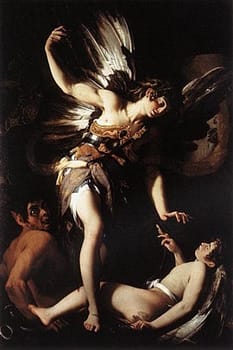
For Baglione, Amor Vincit Omnia simply confirmed the rumor that Caravaggio and Cecco Boneri (his male assistant) were lovers. Baglione produced Divine Love Conquering Earthly Love (1602-03), a parody of Caravaggio’s Amor Vincit Omnia in which he depicted Caravaggio as the devil contriving to sodomize a Cupid (with the central figure of the angel stepping in to prevent the devil from doing so). Caravaggio responded with a wave of satirical verse ridiculing Baglione and his paintings. In the summer of 1603 Caravaggio was imprisoned on charges of libel, brought against him by Baglione. Probably with pressure from del Monte, Caravaggio was released from prison in the fall of 1603 with all charges dropped. Caravaggio quickly recovered from this setback when, in early 1604, he commenced work on the large altarpiece, The Madonna of Loreto (or Pilgrim's Madonna) for the Cavalletti Chapel of the church of Sant'Agostino in Rome. That project was completed, to great popular acclaim, between 1604-05.
Graham-Dixon tells us that in the early 1400s Rome had become home to some 2,000 artists who gathered together in distinct communities (according to their place of origin) and that daily violence, and/or vendettas between different groups, was commonplace. Court records during this period indicate that Caravaggio was involved in myriad scrapes and mishaps of a violent nature, including throwing stones, carrying a sword and dagger in public, defacing a property in an act of revenge against a previous insult (known as deturpatio), and inflicting grievous bodily harm. In one of the more colorful episodes (dated April 24, 1604), Caravaggio started a brawl with a waiter regarding his order of eight cooked artichokes, in which the artist smashed the man's face with a plate. He was only protected from prosecution (as he usually was) because witnesses were reluctant to confirm the artist's involvement in such misdemeanors for fear of reprisal from his influential and prominent patrons.
Between late 1605-06, Caravaggio painted an altarpiece, The Madonna of the Palafrenieri (The Madonna of the Serpent), for the chapel of the papal grooms in St. Peter’s. It was hastily removed from public view, however, due to rumors that Caravaggio had modeled his Virgin (whom he endowed with a full bosom) on (the prostitute) Melandroni. He followed this with what was his last important Roman commission, The Death of the Virgin (1604-06), for the Santa Maria della Scala. But it, too, was quickly removed from public view because Caravaggio had represented Mary and the Apostles as refugees.
Caravaggio's volatile temperament finally caught up with him on May 28, 1606, when he killed the hustler and pimp Ranuccio Tomassoni in an illegal duel that took place on the tennis court of the French ambassador to Rome. Tomassoni was under Melandroni’s control while she was modeling for Caravaggio and this undoubtedly caused considerable friction between them. Graham-Dixon tells us that the two men were probably dueling over the affections of Melandroni or perhaps Tomassoni’s wife. In either case, writes Graham-Dixon, “Caravaggio pierced his opponent’s femoral artery with his dueling sword, causing him to bleed to death in a very short time. The nature of the injury, close to Tomassoni’s groin, may suggest that Caravaggio intended to wound his opponent sexually. Wounds were meaningful in the honour culture of the time, so, for example, a facial wound might be inflicted to avenge an insult to reputation, or loss of face, while a genital wounding or attempted castration might mark a dispute over a woman.”
Caravaggio fled Rome before formal charges of murder were brought against him. He was sentenced in absentia to indefinite exile from the city, condemned as a murderer, and subject to a capital sentence (bando capitale) which allowed anyone in the papal states to receive a monetary reward for killing him (in the absence of his body, the presentation of Caravaggio’s severed head would suffice for the bounty hunter to claim their prize).
Late Period
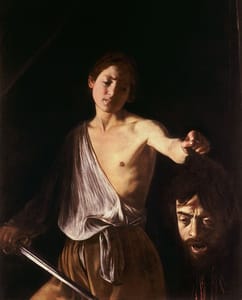
Having fled Rome, the newly convicted murderer and fugitive Caravaggio first took refuge in the Alban Hills in the Colonna territories (about 20 km southeast of Rome). David with the Head of Goliath was produced around this time for the papal nephew, and admirer of Caravaggio’s art, Scipione Borghese, in the hope it might be offered as part of a plea bargain to have his sentence rescinded. If that was Caravaggio’s plan, it did not work. It is believed that for this work Caravaggio cast his assistant (and probable lover) Boneri as David, and himself in the role of Goliath. However, the Borghese Gallery states that more recently it has been hypothesized by scholars that it might be a picture of “the painter rejuvenated, which makes this painting a double self-portrait.”
Caravaggio soon headed south, arriving in the Spanish-controlled Naples in September 1606 where he enjoyed the protection of the powerful condottiero (leader of mercenaries), Fabrizio Sforza Colonna. In the nine months he spent in the city (as a guest at the papal Colonna residence) he produced four altarpieces, The Seven Acts of Mercy, Flagellation of Christ, Crucifixion of St. Andrew, and The Madonna of the Rosary (although the latter, which is noticeably more melodramatic than the others, was probably painted while he was still in Rome and taken with him when he fled).
From Naples, Caravaggio traveled on to Malta. His plan, probably put to him by his host, and long-term friend, Constanza Colonna (daughter of Fabrizio), was to enlist in the religious military order, the Knights of the Order of St. John (or the Hospitallers as they were commonly known). As a member of the Order, Caravaggio would qualify for an automatic pardon in Rome. Caravaggio painted a number of pictures in honor of the Order and its elders, such as Portrait of Fra Antonio Martelli (1608), and the Portrait of Alof de Wignacourt and His Page (1607-08). Wignacourt was the Order’s grand master and was so pleased with his portrait he personally petitioned the Pope for Caravaggio to be granted the status of Knight of Obedience of the Order of St. John. Permission was granted, and Caravaggio set about working on the largest of all his paintings, The Beheading of St. John (1608), for the oratory of the conventual church of Valletta. It was a symbolic painting that warned would-be occupiers of their fate should they try to enter Malta. It secured Caravaggio his pardon and he was once more a free man (if only temporarily).
On the eve of the painting’s unveiling, Caravaggio’s demons possessed him once again and he became involved in a fracas in which he shot and wounded a senior Knight of Justice. Caravaggio was thrown into jail for the offense. With the aid of an accomplice, Caravaggio escaped via an awaiting boat. In late October 1608, he arrived in Syracuse, Sicily, now a wanted man in Rome and Malta (on December 1, 1608, an effigy of Caravaggio was ceremoniously “defrocked” beneath The Beheading of St. John, and he was declared to have been “expelled and thrust forth like a rotten and diseased limb from our Order and Society”).
Despite his not inconsiderable woes, Caravaggio still found the time to paint. He produced a large altarpiece of The Burial of St. Lucy (1608-09), for the Basilica di Santa Lucia al Sepolcro in Syracuse; and two other works: Adoration of the Shepherds (1609) for the Church of Santa Maria degli Angeli in Messina; and Resurrection of Lazarus (1609), for the church of the Padri Crociferi, also in Messina.
By the fall of 1609, Caravaggio was back in Naples, once more a guest at the Colonna Palace. He painted an altarpiece, The Raising of Lazarus, for the church of Sant’Anna dei Lombardi (although the building and its treasures were later lost in an earthquake). His past soon caught up with him, however, and Caravaggio was attacked by four men (thought to have travelled from Malta) outside a tavern. He received serious facial and head wounds (suggesting it was a symbolic revenge attack) and was close to death for several months. Caravaggio painted his last two works in 1610: The Denial of Peter and The Martyrdom of St. Ursula. In these, the “shaky” handling of the paint suggests that he was suffering from hand tremors and/or problems with his vision.
With the backing of Costanza Colonna, Caravaggio re-negotiated his pardon and in July 1610, he set off for Rome, via the port of Palo, with several paintings he would present to Borghese in exchange for granting his reprieve. He was, however, arrested and detained at Palo (although it is not known on what charge). His paintings, however, continued on their journey to Porto Ercole, a small harbor town in Tuscany. Caravaggio, having bought his freedom, rode to Porto Ercole. It was just a day’s ride, but the mid-summer sun, and his poor physical state, caused him to collapse. He died soon after arriving, probably on July 18 or 19, at the age of thirty-eight. He was buried in an unmarked grave.
The Legacy of Caravaggio
Caravaggio has been alternately identified as an exemplar of late Mannerist style, or as a harbinger of the Baroque era. Though only twenty-one works have been definitively attributed to the artist, Caravaggio was a formidable artistic influence both in his time and today. By 1605, other Roman artists such as Bartolomeo Manfredi were beginning to imitate his signature style, and shortly thereafter artists outside of Italy such as Rembrandt and Diego Velázquez were incorporating Caravaggio's dramatic lighting effects into their own landmark works. In particular, painters from Utrecht (known today as the “Utrecht Caravaggisti”), most notably Hendrick Ter Brugghen, Dirck van Baburen, and Gerrit van Honthorst were influenced by his secular subject matter, dramatic use of chiaroscuro, and earthy figures. Caravaggio's paintings also inspired important poets of his time such as Cavalier Giambattista Marino. But despite acclaim in his lifetime and immediately after, by the 18th century, Caravaggio's legacy was all but forgotten, aside from some interest by Neoclassical painters such as Jacques-Louis David. The modern and contemporary fascination with the artist is largely due to the efforts of Italian art historian Roberto Longhi, whose 1951 Milanese exhibition and his 1952 Caravaggio monograph returned the artist to the public eye and cemented his current status.
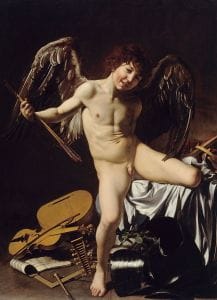
Beyond compositional innovations, Caravaggio's legacy has also been connected to the ostensibly queer content of his paintings, a signifier of his own potential homosexuality. The interpretation of Caravaggio's androgynous, sensual, and partly dressed or naked young men through the lens of homosexual desire is a contested issue within Caravaggio scholarship. Some authors, such as Donald Posner and Graham L. Hammill, unequivocally declare that works such as these represent depictions of queer sensuality and seduction. Others, such as Creighton Gilbert and David Carrier, note that current assessments of the homoerotic content in the artist's work misattribute to the 16th and 17th centuries the codes of 20th-century ideas about queerness and image signification.
That complaint notwithstanding, filmmakers such as Pier Paolo Pasolini and Derek Jarman, have helped secure the artist his place in the Queer pantheon. The lauded gay Italian Marxist, Pasolini (a one-time student of Longhi), created the multi-award winning film The Gospel According to Saint Matthew in 1964 as a clear homage to Caravaggio, while Jarman, a leading figure within the New Queer Cinema movement, recreated the passionate imagery of Caravaggio’s art, and used the artist’s life story to explore his own preoccupations with history, homosexuality, violence, and the connection between painting and film in his 1986 biopic, Caravaggio.
Influences and Connections

-
![Titian]() Titian
Titian -
![Tintoretto]() Tintoretto
Tintoretto -
![Donatello]() Donatello
Donatello -
![Leonardo da Vinci]() Leonardo da Vinci
Leonardo da Vinci - Guido Mazzoni
- Cardinal Francesco
- Maria del Monte
- Costanza Colonna
- Cavalier Giambattista Marino
Useful Resources on Caravaggio
- Caravaggio: The Artist and His WorkBy Sybille Ebert-Schifferer
- Caravaggio: A Life Sacred and ProfaneOur PickAndrew Graham-Dixon
- Caravaggio: Painter of Miracles (Eminent Lives)Our PickBy Francine Prose
- CaravaggioBy John T. Spike
- Lives of Caravaggio (Lives of the Artists)Our PickBy Giulio Mancini, Giovanni Baglione, and Pietro Bellori
- CaravaggioOur PickBy Catherine Puglisi
- M: The Man Who Became CaravaggioOur PickBy Peter Robb
- Caravaggio: A LifeBy Helen Langdon
- Caravaggio: The Complete WorksBy Sebastian Schütze
- Caravaggio and the Creation of Modernity (Renaissance Lives)By Troy Thomas
- Caravaggio: The Complete WorksOur PickBy Rossella Vodret
- CaravaggioOur PickBy Gilles Labert and Gilles Néret
- Caravaggio and Bernini: Early Baroque in RomeBy Frits Scholten
- Caravaggio’s Cardsharps on Trial: Thwaytes v. Sotheby’sBy Richard E. Spear
- The Stolen CaravaggioBy Marius Zarafa
- Caravaggio's SecretsBy Leo Bersani and Ulysse Dutoit
- The Moment of Caravaggio (The A. W. Mellon Lectures in the Fine Arts, 40)By Michael Fried
- Caravaggio’s EyeOur PickBy Covid Whitfield
